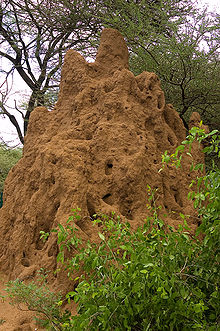User:Puppetsminion
| Rhinotermitidae | |
|---|---|

| |
| Reticulitermes banyulensis | |
| Scientific classification | |
| Kingdom: | |
| Phylum: | |
| Class: | |
| Order: | |
| Family: | Rhinotermitidae Light, 1921
|
Rhinotermitidae[edit]
Rhinotermitidae is a family of termites (Isoptera). They are subterranean based, creating nests just above or below the soil, and usually above the water table. As with all termites, they feed on wood. Given their nesting location, just above or below ground, workers leave the nest and forage for food. This allows them to do significant damage to wooden structures and buildings with little to no cost for the colony. As if or when the structure collapses, the nest remains safely away from the damaged property. 14 genera and 343 species are recognized, several of these species are severe “pest” species. Two of the most economically important, in damage caused, are Coptotermes formosanus and Reticulitermes flavipes. Rhinotermidae are considered “lower” termites, in that they do possess hindgut protozoa, as well as bacteria. This is a diving line in “higher” and “lower” termites, as “lower” termites contain both hindgut protozoa and bacteria, while” higher” termites have only the bacteria.
Rhinotermitidae Castes[edit]
Rhinotermitidae has 4 castes, reproductive (the king and queen), workers, soldiers, and secondary reproductives. This last caste is a semi-reproductive individual. While in the parental nest, they are not reproducing. However, when separated from the nest, they can become primary reproductives, allowing for a new colony to form. This causes problems for people when the termites inside of wooden boards are left out overnight at construction sites. This piece of wood, which was termite free, over time, can spawn a colony of termites inside of the house. A single wood pile can infest multiple houses, over a large geographic range which would normally not be within it’s their normal range. This type of termite transfer has caused the increase of several invasive species in the southern United States. As well as increased the ability of Rhinotermitidae to become an invasive species in many other areas, and ecozones. The soldiers of this family all contain a large pore on their heads, called a fontanelle. Through this pour defensive liquids are secreted. These defensive liquids are usually terpenoids, which protect the nest from both predatory insects, but entomopathogenic fungi, bacteria, and protozoa.
Distribution and Subfamilies[edit]
Rhinotermitidae is primarily a neotropic family, however several genera and species are found in the nearctic, and many have been imported to other ecozones. Subfamilies of Rhinotermitidae (14 genera, 343 species)
- Coptotermitinae Holmgren 1910
- Heterotermitinae Froggatt 1897
- Prorhinoterminae Quennedey & Deligne, 1975
- Psammotermitinae Holmgren
- Rhinotermitinae Froggatt
- Stylotermitinae Holmgren, K & N, 1917
- Termitogetoninae Holmgren
References[edit]
- Grimaldi, D. and Engel, M.S. (2005). Evolution of the Insects. Cambridge University Press. ISBN 0-521-82149-5.
{{cite book}}: CS1 maint: multiple names: authors list (link) - Michael S. Engel and Kumar Krishna. Family-Group Names for Termites (Isoptera)(2004)http://www.bioone.org/doi/abs/10.1206/0003-0082%282004%29432%3C0001%3AFNFTI%3E2.0.CO%3B2
- http://www.bioone.org/action/showFullPopup?doi=10.1206%2F0003-0082%282004%29432%3C0001%3AFNFTI%3E2.0.CO%3B2&id=_e1
| Termitidae | |
|---|---|

| |
| Scientific classification | |
| Kingdom: | |
| Phylum: | |
| Class: | |
| Order: | |
| Family: | Termitidae Latreille, 1802
|
Termitidae[edit]
Termitidae is a family of termite, collectively known as the “higher” termites. It makes up 75%-80% of the termite species, with 2020 species in 237 genera. The majority of the species are found in the tropics. As they are “higher” termites, the hindguts in this family contain no endosymbiotic protozoa and just hindgut bacteria. “Lower” termites contain both hindgut bacteria and hindgut protozoa.
Diet[edit]
Unlike other termite families, wood is only a minor part of their diet. The workers harvest wood, grasses, and any other high cellulose plant material, and bring them back to the nest. Inside the nest is a symbiotic fungus, which digests the cellulose for them. The termites then eat specific parts of the fungus. This is symbiotic, in that the termites feed, tend, and create an environment specifically for the fungus to grow, and the fungus produces parts for the termites to eat. The family of fungus cultivated is only found within the nests of termites in Termitidae, and many of them are specific to certain species of the termites themselves.
Nest Structure[edit]
The family Termitidae creates some of the largest and impressive nest structures in the animal kingdom. Several of the subfamilies, Macrotermitinae being the most widely studied, produce nests of extraordinary size and complexity. The above nest mounds in Macrotermitinae can reach 2-3 meters in height with even large underground chambers. These mounds allow for the air below ground to be climate controlled. As wind blows through and around the top of the mound, it cools the air from the colony, as well as removes some CO2 as well as adds in some oxygen.
Termitidae Subfamilies:[1][edit]
- Apicotermitinae Grassé & Noirot, 1955
- Foraminitermitinae Holmgren, 1912
- Macrotermitinae Kemner, 1934
- Nasutitermitinae Hare, 1937
- Sphaerotermitinae Engel & Krishna, 2004
- Syntermitinae Engel & Krishna, 2004
- Termitinae Latreille, 1802
References[edit]
- Grimaldi, D. and Engel, M.S. (2005). Evolution of the Insects. Cambridge University Press. ISBN 0-521-82149-5.
{{cite book}}: CS1 maint: multiple names: authors list (link) - Sir David Attenborough. Life in the Undergrowth : Supersocieties. (2005) BBC Science and Nature.
